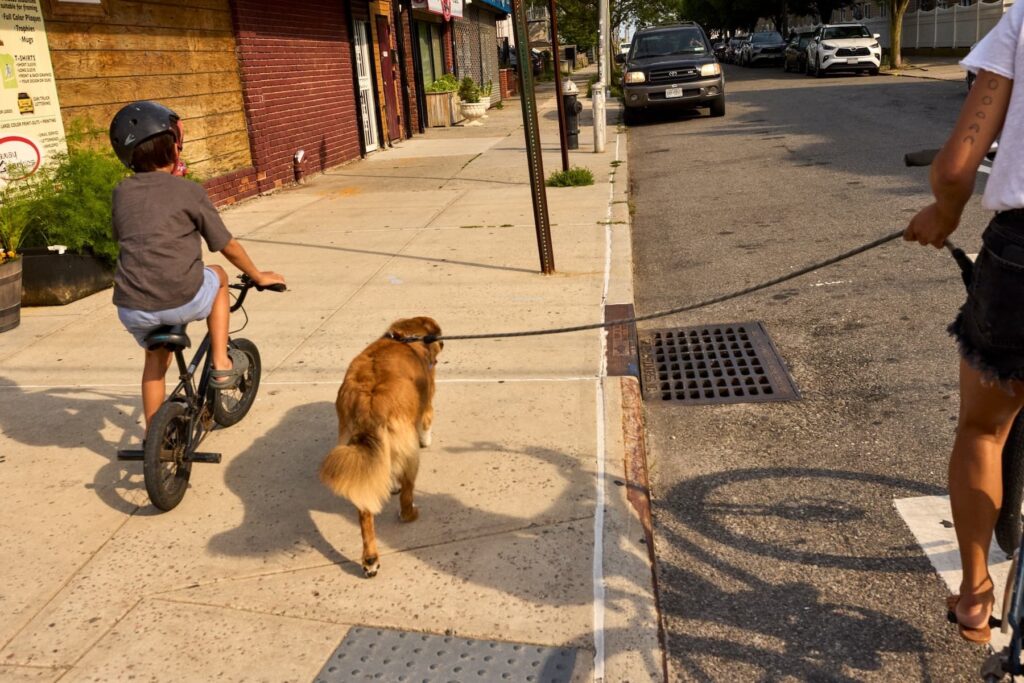When the air is hot, you can usually count on the ground being even hotter. We humans address the scorching ground beneath our feet with footwear. But for our dogs and their bare paws, the pavement poses a serious danger. Here’s how to determine whether the material under your dog’s precious paws poses a risk to them, and what to do about it.
If it’s too hot for you, it’s too hot for them.
In adult humans, the perception of pain starts when skin touches a surface that’s 109.4 degrees Fahrenheit, and the risk for a burn can begin at 111.2 degrees Fahrenheit. Paws may be slightly more rugged because regular exposure to the elements has toughened them up—but for the purposes of evaluating the risk, we’re going by this rule of thumb: “If you’re hot, they’re hot.”
“Typically if something hurts us, it will hurt our dogs. While their paw pads are basically thick callouses, they are highly vascular and sensitive to pain,” says Dr. Alex Schechter of Burrwood Veterinary in Detroit.
The ground is probably hotter than the air.
Keep in mind that 111.2 degrees is far below the temperature of many ground materials during the summer.
A 2020 study published in the Journal of Burn Care and Research measured temperatures of various ground materials in a desert climate across six months. The study recorded maximum temperatures of various materials on a day when the ambient temperature was 120 degrees Fahrenheit. All of the surfaces were much hotter than the air. Porous rock was measured at 170 degrees, asphalt at 166 degrees, brick at 152 degrees, concrete at 144 degrees, metal at 144 degrees, and sand at 143 degrees.

This is all to say that many types of surfaces can get screaming hot, to use a scientific term. But you and your dog don’t have to be in a full-on desert environment to risk exposure to dangerous surface temperatures. According to the American Burn Association (ABA), pavement can reach a temperature of 125 degrees when it’s just 77 degrees outside, a temperature easily reached during summer months in most U.S. climate zones.
Try the “seven-second rule.”
Many things can affect how hot a surface gets. Everything from air velocity to how reflective the material is will drive the temperature up or down. It can be nice to know how things work in order to inform your choices, but you don’t necessarily need a degree in materials engineering to determine whether it’s safe to take Buddy for a spin around the neighborhood on a hot day. You can use the seven-second rule.
The rule goes like this: put your hand flat on a surface and count to seven. If it’s too hot to hold it there for all seven seconds, then it’s too hot for your dog.
Follow your dog’s lead.
Dogs are pretty good at communicating discomfort. A dog that is trying to avoid hot pavement may seek shade, pick up their paws, or whimper. The best thing you can do is heed their concern and head quickly to safer ground.
So the pavement is indeed too hot. Now what? Walk in the morning before the temperature rises, or the evening after the sun goes down.
Midday tends to be the hottest time of day, so try heading out early and/or very late. Keep in mind, however, that asphalt has low thermal conductivity, meaning that it’s slow to release heat. It can stay very hot even after the sun goes down—so be sure to check the pavement before letting your dog’s paw touch down, even at night.
Seek shade.
The 2020 study mentioned above also noted that the surfaces the authors measured were in the sunlight—and were 36 to 56 degrees hotter than those in shaded areas. The shade might offer some relief underfoot.

Walk on natural grass, if possible.
Natural grass is better at reflecting heat than pavement, which absorbs it (artificial turf will likewise hit higher temperatures).
Make your outdoor bathroom break quick, and play indoors.
If it’s just too hot to walk outside, and especially if you live in a city or suburb where grass-filled acreage is harder to come by, you might consider skipping the walk entirely. There are great enrichment activities you and your dog can partake in when you’re stuck indoors. Get creative! “Hall ball” is a favorite in our house.
A note on booties
Booties can be an option if your dog tolerates them. However, Dr. Schechter offers two caveats, the first being: “If the pavement is very hot, the outside [air] temperature is likely hot as well. Dogs are susceptible to heat stroke due to their fur coat and inability to sweat. So even if their feet are protected by booties, we have to think of them as a whole entity. Perhaps the walk outside isn’t worth the risk.”
Secondly, he says that dogs’ paws are a tool for managing heat naturally. “Dogs can dissipate some heat from their paws—so if their paws are covered with booties, they may lose some of their cooling ability,” he adds.
Here’s what you can do if your dog’s paws get burned despite your best efforts.
“Burns can be very painful and the open sores may put your dog at risk for infection, so prompt action is encouraged,” Dr. Schecter says.
In order of severity, the things to look for on the bottom of your dog’s feet are redness, cracking, peeling, blistering, bleeding, or necrosis, i.e. dead tissue. “If there is redness, tenderness, limping, or ulceration to the paws,” Dr. Schechter says, “your dog should be evaluated by a veterinarian for treatment.”
The post The Simplest Way to Tell if the Pavement Is Too Hot for Your Dog’s Paws appeared first on The Farmer’s Dog - Digest.
Comments
Post a Comment